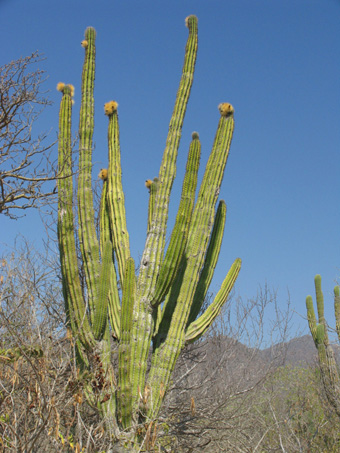BEE MARCH 2019
What's That Plant?
So many times, I´ve heard visitors here in Baja California talk about those amazing Saguaro cacti that they saw while driving down the Transpeninsular Highway. Or the Teddy Bear Cholla that looked so cuddly but tried to jump onto them as they walked past. Locally, visitors to Mulegé (and southward) often remark on the wonderful flowers of the Ocotillo that can bloom within just days of a light winter rain. Being the stickler that I am for calling things by their correct names, it drives me crazy and I’d like to set the record straight! This month, I’m taking on the issue of the Saguaro and will follow up next month with the others.
Is that really a Saguaro?
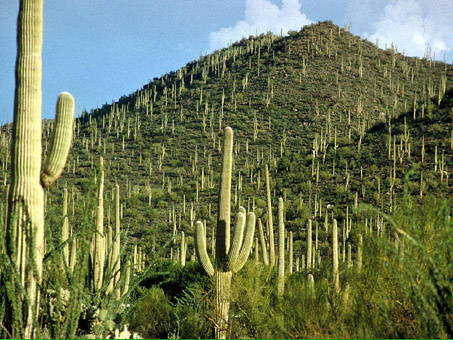
Saguaro/Sahuaro (Photo credit: Internet, slide 16)
It´s easy to tell if the giant, arborescent cactus you saw is a Saguaro (Carnegiea gigantea) or not. Just ask yourself where you saw the cactus.
If your answer is “on the Baja peninsula” (both states of BC and BCS), then it´s not a Saguaro. See? Easy!
Simply put, the Saguaro does not occur on the peninsula.
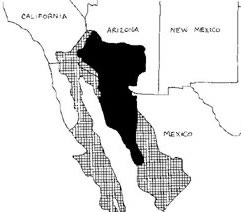
Range map of Carnegiea gigantea. Hatchmarked area is the Sonoran Desert, with Saguaro range in black. (Source: National Park Service).
If your answer is “California or Arizona”, then yes, you saw a saguaro. Saguaros are found in Arizona as well as a very small area in the southeast corner of California near the Arizona border.
If your answer was Sonora, Mexico, then what you saw was most likely, but not certainly, a saguaro…(read on).
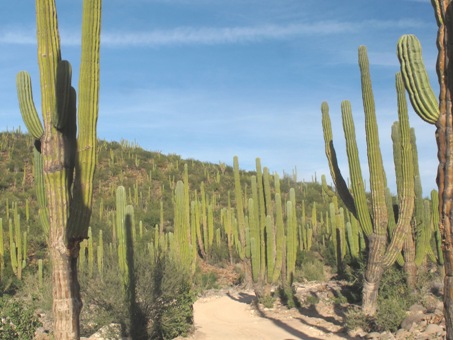
Cardonal (a forest of Cardón), Santa Gertrudis, BC.
The giant arborescent cactus that is found on the peninsula is the Cardón (Pachycereus pringlei), also known as Cardón pelón (pelón means bald in Spanish) and Elephant Cactus. It is a peninsular near-endemic, meaning that while it is native to the peninsula, it is also found elsewhere naturally, but in a very restricted area.
And that elsewhere is along a narrow fringe of western Sonora, from around the area of Ciudad Obregón to north of Isla Tiburón, where Cardón (or Sahueso as it is more commonly called in Sonora) grows along with the Saguaro, but is much less common and abundant. So, that is why the identification of the giant cacti in Sonora isn’t so straightforward based solely on location.
"But, what? Not all Cardons are the same?"
Ready now for another twist? If your answer about your location was "on the Baja California peninsula, from just north of La Paz southward to the Cape Region (in other words, closer to and within the peninsula´s tropical zone) then you may have seen another Cardón species, Cardón Barbón or Etcho (Pachycereus pecten-aboriginum).
Barbón means bearded in Spanish, while the English common name is Hairbrush cactus, named for the indigenous people's historical use of the spiny fruits. This is a more (sub)tropical species, also found along western mainland Mexico, including the states of Sonora, Sinaloa and Chihuahua.
In this article, for clarity, I will refer P. pringlei as just Cardón and to P. pecten-aboriginum as Cardón barbón.
To help solidfy your ability to tell these three species apart, you’ll need to know a little more about them, mainly some distinguishing characteristics about each. That's where this article will hopefully help you out.
Carnegiea gigantea (Saguaro)
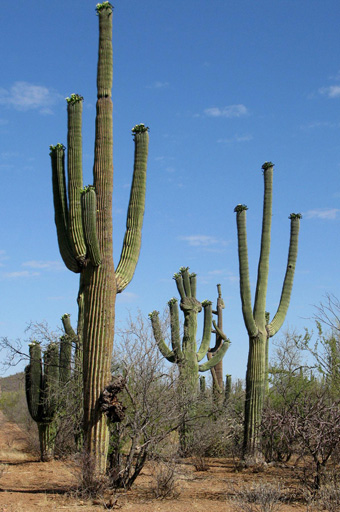
Saguaros reach 3-16 m (10-52 ft) in height with a trunk about 1.5-2 m H [1]. The ribs are distinctive almost all the way to the base. The clusters of flowers at the tops of the stems in this image remind me of toupés stuck on the tops. (Photo credit: Thomas K. Van Devender; CC BY-NC 3.0).
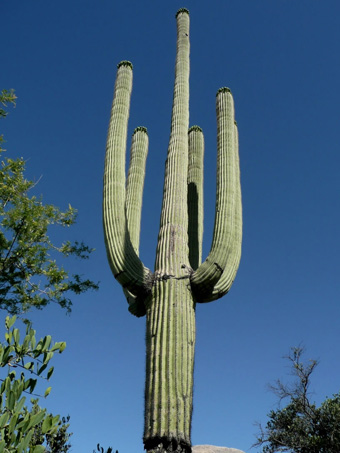
Saguaro/Sahuaro. Note that the widest part of the cactus is the midsection where it branches. (Photo credit: Charlie McDonald, US Forest Service).

Young Saguaro stem tip (front) with older stem behind. Spines less visible, but still present in most of the older areoles (the structures where spines, flowers and fruit originate). (Photo credit: Univ. Arizona Arboreteum).
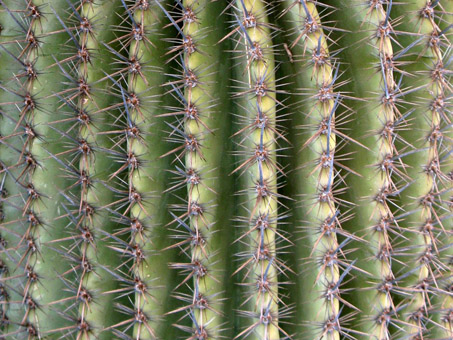
The saguaro stems have 12 to 30 ribs. Each areole has 15-28 spines on average (8-50 less commonly) with 4-7 central spines. Some spines are lost with age, but are much more prevalent throughout the plant. (Photo credit: Thomas K. Van Devender, CC BY-NC 3.0).
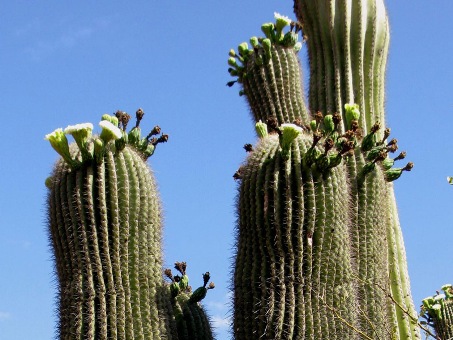
Saguaro flowers are mostly found at the tips of the stems where they form a crown, but may appear sparsely, up to 1 m below the tips. (Photo credit: Thomas K. Van Devender, CC BY-NC).
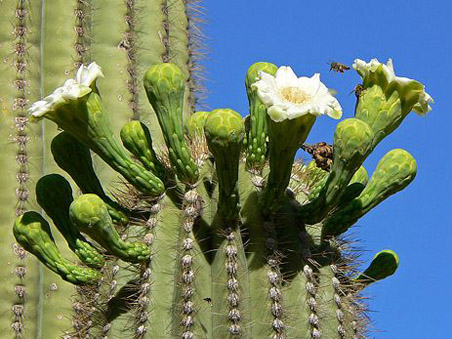
Saguaro stem tip with flowers. Note the presence of long spines on the stem but the lack of spines or bristles on the tube of the buds and flowers. Also, note the shape of the buds and flower tubes. (Photo credit: Stan Shebs, CC BY-SA).
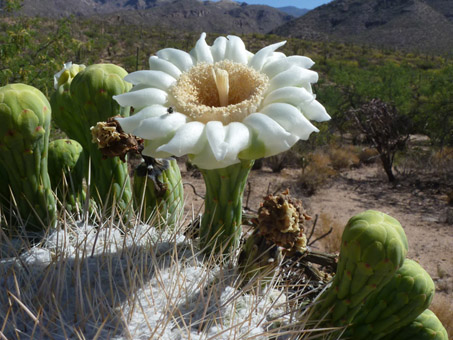
Saguaro flowers showing the long floral tube. The outer perianth segments are elongated, leaf-like and glabrous. (Photo credit: Max Licher, CC BY-NC).
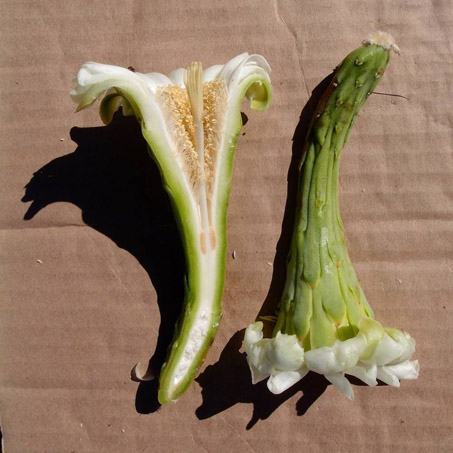
Saguaro flower (cross-section). Note the elongated tube; the flower is 8.5-12.5 cm L and 5-6 cm D. Inner perianth segments are white and rotate to reflexed. (Photo credit: Sue Carnahan, CC BY-NC).
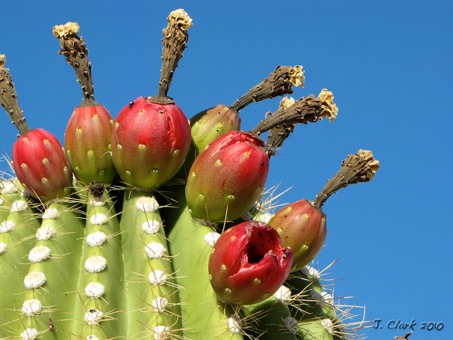
The Saguaro fruit is ovate, scaly but glabrous or with some bristles near the base, edible and 4.5-7.5 cm L x 2.5-4.5 cm D. It has many tiny black seeds. (Photo credit: J. Clark 2010). Seeds?
Pachycereus pringlei (Cardón)
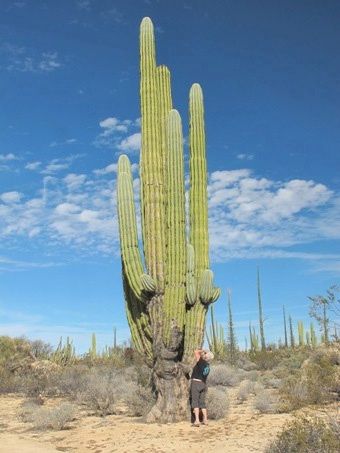
This Cardón is probably 10+ m and has a very distinct, enlarged trunk. Trunks are gen. 1-2 m H and plants reach 10-30 m H [2]. This is a medium-sized specimen for the area of this photo. The trunk's epidermis is thickened can resemble smooth bark. The ribs are very flattened or poorly defined and have few to no spines. The trunks often look like an elephant's foot [3]
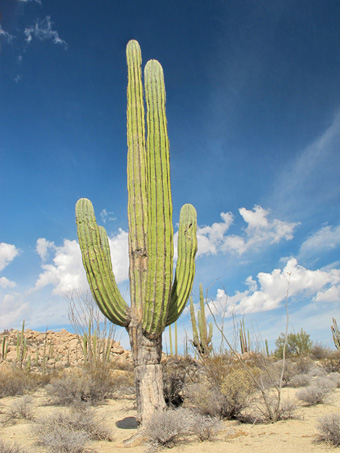
A smaller Cardón specimen. The main stem is not necesarily wider where it branches, like in the Saguaro and with age, the trunk most often becomes the widest section.
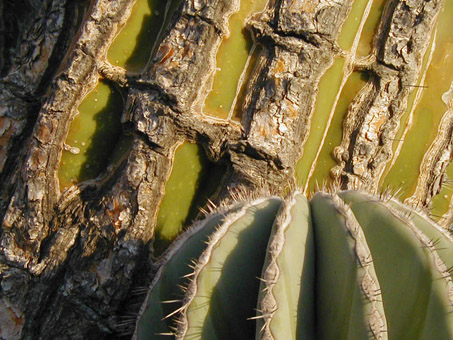
Young Cardón stem tip (front) with older stem behind. The older stem is hardening into what looks a lot like bark. The epidermis of the young stems commonly have glaucous, bluish-green chevron markings interspersed with bright green tissue. See image below.

There are three separate stems in this photo. The Cardón stems have fewer ribs (11-19) and they are broader and farther apart than in the saguaro. As the cactus grows and ages, most of the spines are lost and not replaced, giving it its moniker of the "bald" cardon. There are 20-30 spines per young areole with 3 central spines and 12+ radial spines. The areoles are wooly white.

Cardón flowers most noticeably appear in an arc of about 270 degrees around the upper portions of the stems between SE to SW. They may extend several meters down the stems.
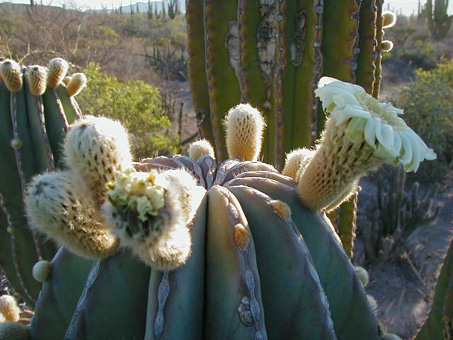
Note the near lack of spines on this Cardón stem tip, and the dense, very short bristles on the buds and the tube of the flower. Compare the shape of the buds and flowers with the Saguaro (left). As in this photo, the flowers sometimes do cluster near the top, but it's not very common.
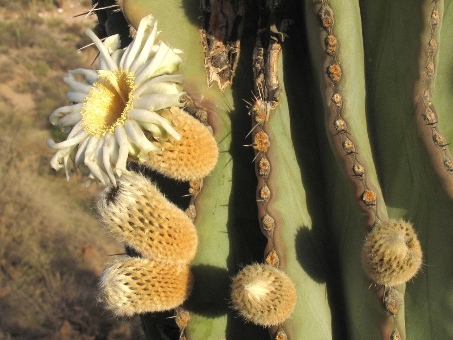
Cardón, with densely bristly outer perianth, the bristles clustered in areoles between the perianth segments which can be seen as the narrow dark marks between the clusters of hair.
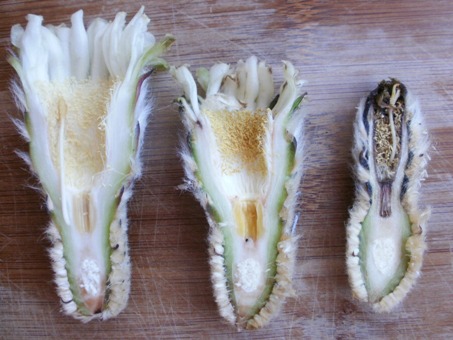
Cardón flowers in cross section. The inner perianth segments are white and glabrous and are rotate to reflexed. The individual areoles with their clusters of bristles are more visible here. Flowers are 4-6 cm D, and about 4-8 cm L.
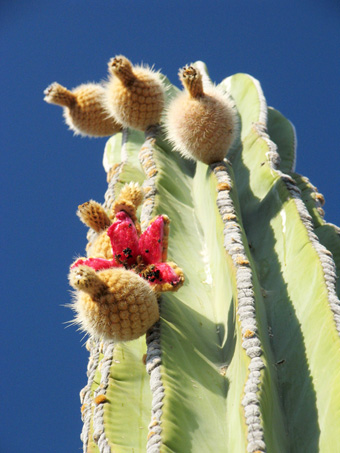
The Cardón fruit is globose, about 4-7 cm D and densely short-bristly. The bristles are rarely greater than 1 cm L [2]. It is juicy and edible, with many tiny black seeds.
Pachycereus pecten-aborigenum (Cardón Barbón)
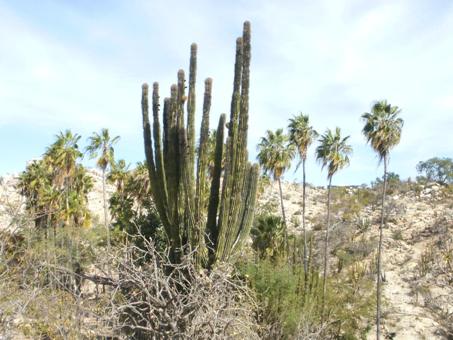
Large P. pecten-aboriginum in the arid tropical forest of the east Cape Region. The stems tops look blurry, but are in fact quite bristly. This is an example of the species' pseudocephalium, an area along the upper stems where there is an increase in spines or bristles. In other words, a beard!.
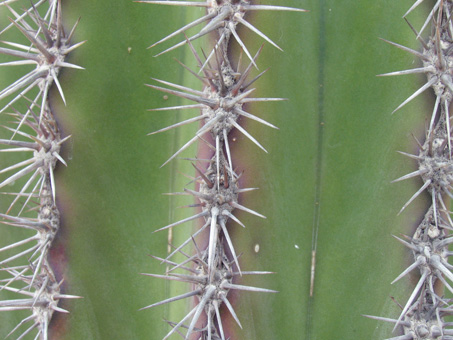
P. pringlei spines for comparison. There are 20-30 spines per young areole, which is white and felted. It grays with age.

P. pringlei flower. The tiny purple things are the tips of the lower perianth segments. Note the bristles between the segments (and clustered at the areoles), but much reduced in the flower bud of P. pecten-aboriginum, visible only near the very base (photo, right).

The golden fruit of the Cardón Barbón are about xx cm D with long, densely packed bristles 2-6 cm L and persistent at maturity. The fruit is dry and inedible.
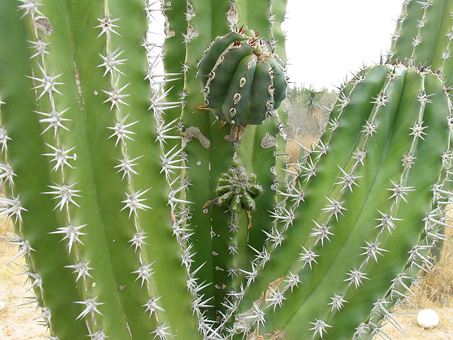
Cardón barbón has only 10-12 ribs per stem which is 15-25 cm D. Very large specimens rarely exceed 10 m, with many just around half that. In general, the stems and branches are about half the girth of a P. pringlei of the same age [4].

P. pecten-aboriginum has only 8-12 spines per young areole. The young areole is reddish-brown and felted; it becomes gray with age.
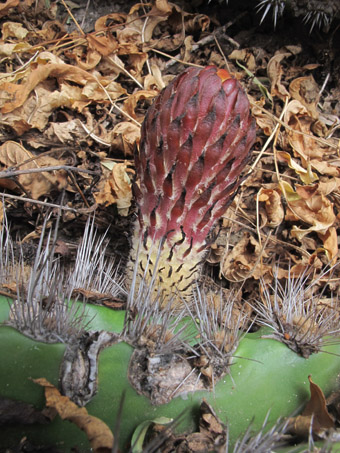
A Cardón barbón stem on the ground in the leaf litter of the Santuario de los Cactos (here´s another link to the Santuario de los Cactos). It was broken off in a hurricane. The flower is ready to bloom. Note the lack of bristles throughout most of the bud and the very bristly areoles along the pseudocephalium of the stem.
Pachycereus Links
According to the Arizona Sonora Desert Museum´s fact sheet, the Cardón Barbón "is the most common columnar cactus in the lower tropical deciduous forest of southern Sonora".
Illustrations of the Cardón barbón plant.
Some More Images of Cardons

P. pecten-aboriginum in native habitat, the arid tropical forest of the Cape lowlands, along with leguminous and elephant (Bursera spp.) trees. Tree species are commonly much taller than the cacti.
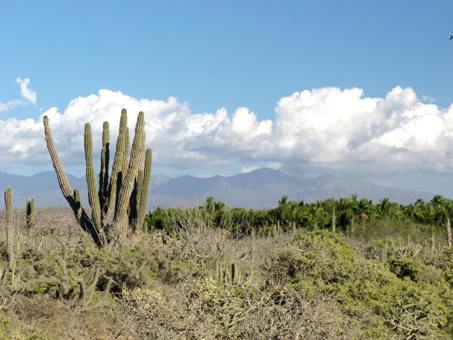
P. pecten-aboriginum in native Cape Lowlands habitat, along the Pacific coast near Todos Santos, BCS.
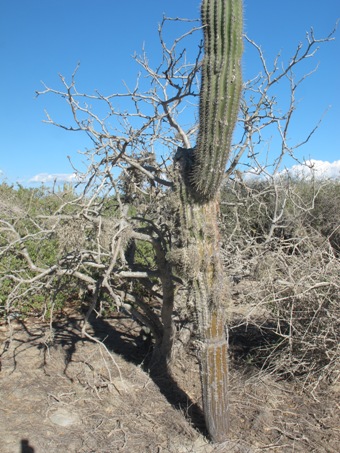
A young P. pecten-aboriginum in the lowland coastal scrub near Todos Santos (Cape Region). The trunk has lichens growing on it, as do most of the other plants in the area. The spines are quite long and noticeable, even near the bottom of the stem.
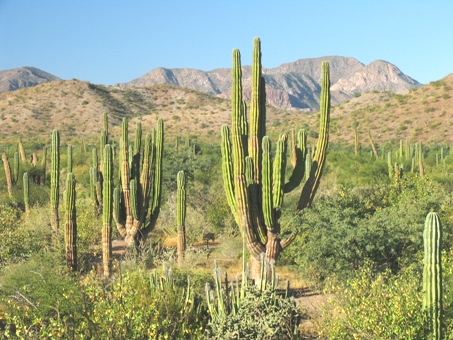
P. pringlei of various ages in desert scrub of the Central Gulf Coast near Mulegé. They are usually the tallest species in this habitat.
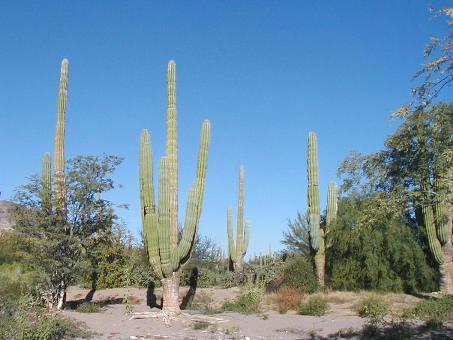
P. pringlei along a wash near Bahía Concepción, BCS. Note the wide reaching roots exposed by a flash flood.
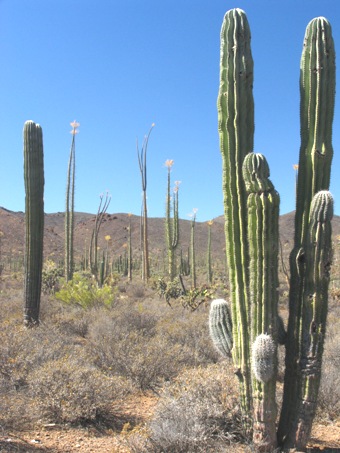
P. pringlei of perhaps the same age range and size as the cactus in the photo on the left. Only the youngest branches have dense spines while the bottoms of the stems appear bald.
Time to Test Your Skills
1. You are currently in El Marmol, Baja California. Name those giant, arborescent cacti on the open plain.
2. You drove from Yuma to San Diego on Hwy 8. Name those giant, arborescent cacti on the hillsides near the border.
3. You camped south of La Paz, near Todos Santos, B.C.S. Name those arborescent cacti surrounding your camp.
(Answers are at the end, below the reference section)
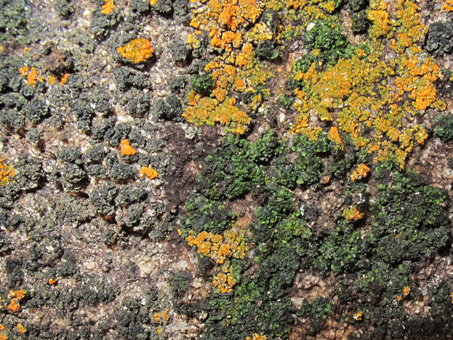
What could be moss mixed in with the lichens...
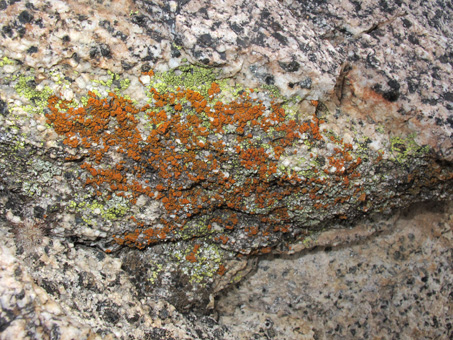
Definitely lichens nearby.
Back at the bottom of the boulder fields, still up on the mesa, I had just stopped to catch my breath, take a drink of water and open a snack, when my eyes fell on a grayish, velvety patch on the boulder right next to my backpack. I couldn't believe it! A patch of what was unmistakably moss (below, left). An almost invisible and much thinner layer of moss than what I had found before in Cataviña or the Sierra San Francisco. This probably explains why I hadn't found any until here until now – I was expecting something much thicker that stood out more.
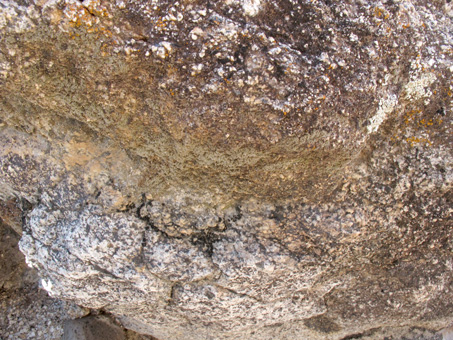
Can you find the patch of moss in this photo?

Or in this one?
And of course as I headed back to meet up with my partner, I passed a 2nd patch of the same moss (above, right)! Ironically about 12 inches away, and under a small ledge, from where I had taken a picture of a bright orange and yellow patch of lichens the evening before. I´m blaming my glasses!
I yelped with satisfaction at having found more moss and, with a big smile, headed back down the hill to base camp. Short-lived victory. Under the hand lens, my first collection proved not to be a moss, but very leaf-like squamulous lichen.
 Nonetheless, I was feeling quite content about the small success that I'd had finding both moss and ferns in Santa Gertrudis. I had collected two moss species and had seen two fern species as well. The cool thing is that when I returned home and checked the squamulose lichen under the microscope, at first I only saw small blackish balls of tightly packed dry lichen, but when these were wetted they turned green and quickly unfurled to reveal small leaf-like, overlapping thalli…and some tiny, individual moss plants tucked carefully inside (circled in red)!
Nonetheless, I was feeling quite content about the small success that I'd had finding both moss and ferns in Santa Gertrudis. I had collected two moss species and had seen two fern species as well. The cool thing is that when I returned home and checked the squamulose lichen under the microscope, at first I only saw small blackish balls of tightly packed dry lichen, but when these were wetted they turned green and quickly unfurled to reveal small leaf-like, overlapping thalli…and some tiny, individual moss plants tucked carefully inside (circled in red)!
That's it for this month. I have no idea what next month will bring. So, until then, hasta la próxima…
Debra Valov—Curatorial Volunteer
References
[1] Jepson eFlora
[2] Wiggins
[3] Pachys: thick in Greek; cereus refers to the genus of arborescent, candelabra-like cacti (with root in the French cera, candle).
[4] Wiggins
(click on the link for each reference to return to your previous location on this page)
Quiz Answers
1. Saguaro; 2. Cardón; 3. Cardón barbón.





